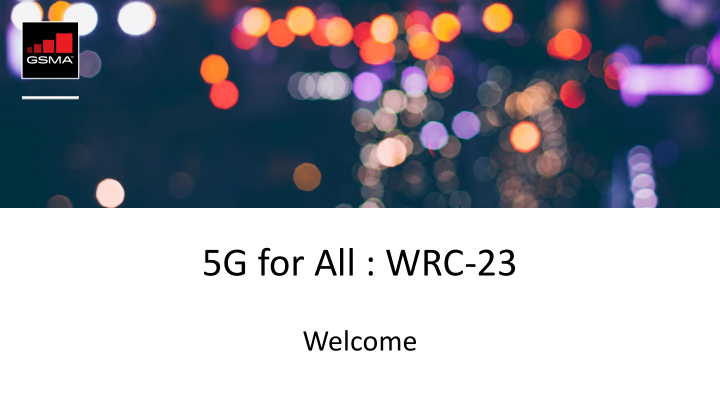



5G for All : WRC-23 Welcome
5G for All : WRC-23 Welcome Brett Tarnutzer Head of Spectrum GSMA
Mobile and the Power of Spectrum No one has done more with their spectrum to deliver a better future for everyone than the mobile industry
Coverage and Cost WRC-23 can provide solutions to long-standing problems Usage Gap Coverage 4BN 90% Mobile Broadband MORE PEOPLE ARE NOT now connects around CONNECTED BUT 4BN 3.3BN of the world’s population is covered by LIVE WITHIN MOBILE PEOPLE TO Mobile BROADBAND COVERAGE THE INTERNET Broadband
WRC-23: An Opportunity to Get it Right WRC-23 can support greater coverage and affordable broadband and drive 5G forward Increase wide-area Get city-wide capacity New applications, IoT Ensure Radio spectrum capacity to harmonised, catch up and MMTC can receive Regulations reflect enhance digital inclusion with early adopters and better access to the reality and drive global and achieve social goals enhance 5G harmonisation frequencies they need
5G for All : WRC-23 Luciana Camargos Senior Director, Future Spectrum GSMA
WRC-23: Solutions for Three Familiar Challenges • Further harmonisation in core bands – like 3.5 GHz – for global ecosystem Harmonisation • New harmonised spectrum for 5G expansion – e.g. 6 GHz • Ensure 5G has sufficient channel bandwidth: 3.5 GHz, 4.8 GHz, 6 GHz Cost-Efficiency • Channel size will lower network density and increase affordability • City-wide capacity solutions (AI 1.1, 1.2, 1.3) Coverage • Low-band spectrum for rural 5G and universal IoT (AI 1.5)
WRC-23 IMT Agenda Items Overview Region 1 Region 2 Region 3 Bands 470-960 MHz 3300-3400MHz 3600-3800MHz 4800-4990 MHz 6425-7025 MHz 7025-7125 MHz 10-10.5 GHz IMT FS Region 1 AI 1.5 (IMT) AI 1.2 (IMT) AI 1.3 (MS) AI 1.1 (IMT) AI 1.2 (IMT) AI 1.2 (IMT) 9.1.c Region 2 AI 1.2 (IMT) AI 1.2 (IMT) AI 1.1 (IMT) AI 1.2 (IMT) AI 1.2 (IMT) 9.1.c Region 3 AI 1.1 (IMT) AI 1.2 (IMT) 9.1.c
Harmonisation: beyond the Radio Regulations WRC-23 can move regulations closer to reality in 3.3-4.2 GHz HOWEVER … 1 Progress at WRCs does not always match market forces and early adopters have moved well past decisions 2 0 MHz WRC-23 can play catch up and give regulators 100 MHz chance to plan for 5G with sufficient channel 200 MHz bandwidth to lower costs 300 MHz 400 MHz
Harmonisation: beyond the Radio Regulations WRC-23 can help lower digital divide HOWEVER … 3 Regional evolution beyond WRC decisions has seen wider harmonised capacity – and lower costs - in most developed markets. 4 0 MHz Radio regulations and reality do not match. 200 MHz Wider harmonised capacity is needed to 300 MHz ensure balanced spectrum availability 400 MHz across markets. 500 MHz or more
Harmonisation: 6 GHz at WRC-23 6 GHz represents new challenge in building robust mobile ecosystems 6425 MHz 5925 MHz 7025 MHz 7125 MHz Potential use for licensed or unlicensed 5G, Wi-Fi WRC-23 Discussions China Licensed Europe Europe TBD @ WRC-23 Unlicensed US Unlicensed
Cost Efficiency Planning 5G with enough spectrum to allow sufficient bandwidth will increase performance and significantly reduce costs. Wider channels mean fewer base stations 100 MHz 60 MHz 64% CHANNEL SIZE INCREASE IN IMPACT NUMBER OF CELL SITES WRC-23 can make huge savings on 5G roll-out ADDITIONAL 700MHz ADDITIONAL 300MHz GLOBAL BENEFITS $50bn $80bn Adding additional bandwidth to the baseline 200 MHz in 2GHz range*
Cost Efficiency Network cost savings with 300 MHz more 3.5 GHz spectrum than WRC-15 decision is assigned to operators By Regions North America Europe & Central Asia CIS 300 MHz 300 MHz 300 MHz $4bn $16bn $1.5bn MENA South Asia South East Asia AI 1.1 (IMT) 300 MHz 300 MHz 300 MHz 4800 – 4990 $4bn $2bn $3.5bn MHz Latin America AI 1.2 (IMT) 300 MHz 3300 – 3400 MHz IMT in Fixed $3.5bn 3600 - 3800 MHz Service 7025 – 7125 MHz Sub-Saharan Africa East Asia & Pacific 10-10.5 GHz Topic 9.1c 300 MHz 300 MHz AI 1.1 (IMT) $3bn $14bn Cost savings if spectrum is assigned above the 200 MHz baseline in the 3.3-4.2 GHz range
Coverage WRC-23 can support greater coverage and affordable broadband Increase wide-area Make wider coverage IoT and MMTC can Rural areas can get spectrum capacity to affordable to allow for receive better access to better access to 5G enhance digital inclusion wider achievement of low frequency spectrum through sub-1 GHz social goals spectrum
Why more UHF for mobile? • Increased capacity and performance in areas where higher frequencies Digital Divide are not effective • Rural users require advanced communications services like anyone else • Consumers require consistent user experience with 5G Reliability • ‘Best effort’ 4G speeds no longer viable for many 5G use cases • Outside broadband, UHF is required for new 5G use cases: New uses • IoT (with low power consumption) • V2X (with consistent user experience)
WRC-23 Timeline WRC-19 Mid 2021 CPM23-2 WRC-23 3 1 2 Deadline Nov 2019 Early 2023 Nov 2023 Characteristics Sharing Studies Final Engagement Spectrum Needs CPM Text Propagation Model
Conclusion: what is needed • Collaborate: mobile must make its needs clear and work with government Demand • Plan 4G and 5G together • Ensure that 5G is not just an urban solution • Agree on 100 MHz channels: ITU, EU and others do Harmonisation • Get 3.5 GHz band sorted for 5G • Look at 6 GHz as next major 5G expansion band • Take long-term view and make strong UHF decisions Coverage • Plan now to make changes in the 2030s
Panel Discussion IMT at WRC-23 Moderator Luciana Camargos, GSMA Lisa Amirault, ISED Agostinho Linhares, Jose Luis Ayala, Ericsson Pascale Dumit, T-Mobile Canada Anatel Brazil USA
Closing Remarks and Vote of Thanks Head of Spectrum, GSMA Brett Tarnutzer Harmonisation Coverage
Thank you
Recommend
More recommend